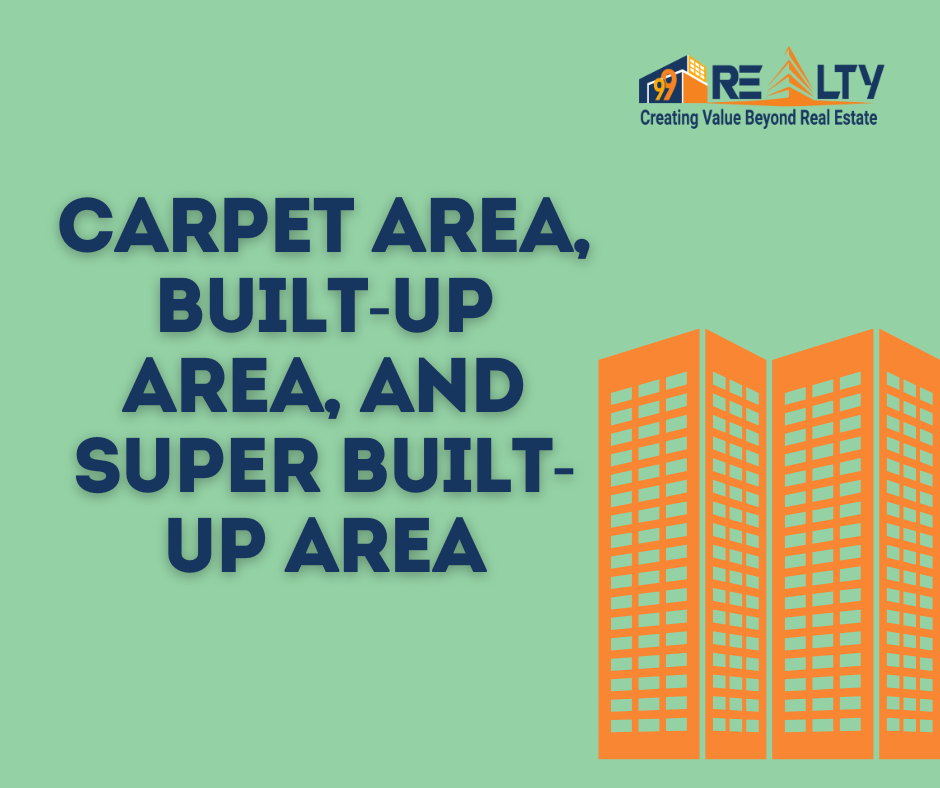When navigating the real estate market, especially when purchasing an apartment or house, it’s essential to understand the core concepts of carpet area, built-up area, and super built-up area. These measurements directly influence pricing, usability, and investment value, as they define the amount of space you’re paying for and using. Familiarizing yourself with these terms ensures that you make an informed purchase decision and negotiate effectively with developers.
What is Carpet Area?
The carpet area is the net usable floor space within an apartment or house that you can cover with a carpet. This area includes:
- Bedrooms
- Living rooms
- Dining areas
- Bathrooms
- Kitchen space
Important Points:
- Excludes: External walls, balconies, lobbies, and common areas.
- Represents: The actual, practical living space within your property.
Formula to Calculate Carpet Area:
Carpet Area=Total Usable Area−Inner Wall ThicknessExample:
If a flat has a total built-up area of 1,500 sq. ft., and the inner wall thickness occupies around 10%, the carpet area will likely range between 1,200 to 1,300 sq. ft.
Understanding RERA Carpet Area
Under the Real Estate (Regulation and Development) Act, 2016 (RERA), the term “RERA Carpet Area” was introduced to standardize measurements across properties. The RERA Carpet Area includes internal partition walls, thus typically 5% larger than the general carpet area. However, like the standard carpet area, it excludes balconies, terraces, and other external areas.
RERA Carpet Area Formula:
RERA Carpet Area=Carpet Area+Internal Partition Wall AreaWhat is Built-Up Area?
The built-up area includes the carpet area, as well as the thickness of both internal and external walls, along with areas such as balconies or terraces. This measurement gives a broader understanding of the actual space you occupy but not necessarily all usable.
Key Components:
- Carpet Area
- Wall Thickness (both internal and external)
- Exclusive areas like balconies or terraces
Built-Up Area Formula:
Built-Up Area=Carpet Area+Wall Area+Balcony/Terrace AreaExample Calculation:
If the carpet area is 1,200 sq. ft. and wall thickness and balcony add an extra 15%, the built-up area becomes approximately 1,380 sq. ft.
What is Super Built-Up Area?
Also known as the saleable area, the super built-up area is the built-up area combined with a proportionate share of common areas like lobbies, staircases, and amenities such as clubhouses and elevators. This area is often used to determine the price of a property, as it includes shared spaces that enhance the value and functionality of the property.
Components Included:
- Built-Up Area
- Proportionate share of common areas such as:
- Lobby and corridors
- Lifts
- Clubhouse
- Staircases
Super Built-Up Area Formula:
Super Built-Up Area=Built-Up Area+(Loading Factor×Carpet Area)Loading Factor:
The loading factor is a percentage (typically between 25-60%) that reflects the share of common areas attributed to each property unit. This multiplier can vary based on the project’s layout and amenities.
Differences Between Carpet, Built-Up, and Super Built-Up Areas
| Area Type | Includes | Excludes |
|---|---|---|
| Carpet Area | Usable floor space | Walls, balconies, common areas |
| Built-Up Area | Carpet Area + wall thickness | Common areas |
| Super Built-Up | Built-Up Area + common spaces | Open-to-sky amenities, inaccessible areas |

Why Should Buyers Understand These Areas?
Understanding these distinct terms can help potential homeowners and investors avoid paying unnecessary premiums, accurately estimate usable space, and negotiate better deals. Here are some vital points to consider:
- Focus on Carpet Area: The carpet area is the actual usable space, so prioritize this measurement when comparing properties.
- Compare Cost per Sq. Ft.: Always calculate the cost per square foot based on the carpet area to get an accurate valuation.
- Beware of High Loading Factors: High loading factors may result in a larger super built-up area but relatively lesser usable carpet area.
Also Read: Comprehensive Guide to GST on Real Estate in India
Key Takeaways for Homebuyers
- Carpet Area reflects your actual living space and should be your priority.
- Built-Up Area includes additional spaces but does not necessarily increase your usable area.
- Super Built-Up Area is commonly used for pricing and includes shared amenities; knowing this area helps you gauge the total contribution to the building’s communal features.
A clear understanding of carpet area, built-up area, and super built-up area empowers buyers to assess the value they’re receiving, enabling better choices and negotiations. Familiarize yourself with these terms, calculate accurately, and always verify details in your property contract to ensure transparency and satisfaction with your real estate investment.
Subscribe to get updates on our latest posts and market trends.






Join The Discussion